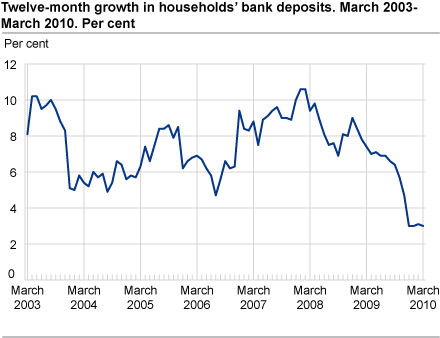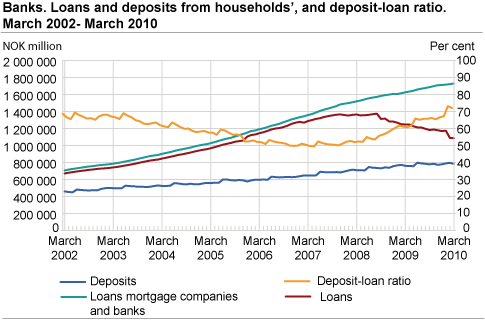Content
Published:
This is an archived release.
Declining growth in households’ bank deposits
Norwegian households' deposits in Norwegian banks were NOK 782 billion at end-March 2010. This is a decrease of 3 per cent compared to March last year.
Despite low interest rates, deposits have increased in the last year. However, the figures indicate that the twelve-month growth in this period was low in a historical perspective. For more information on the development in deposits, go to the money supply statistics .
Decrease in banks' loans to households
Norwegian banks' loans to households were reduced by 12.9 per cent, from NOK 1 246 billion to NOK 1 086 billion from March 2009 to March 2010. An important reason for this decrease is transfers of loan portfolios from banks to mortgage companies within the same company group. Portfolio movements have become more common as a consequence of the new regulations for bonds with right of priority, which were introduced on 1 June 2007 (see box). This means that the real growth in loans is not always reflected by the growth in one of the financial institution types in isolation.
For mortgage companies and banks as a whole, the growth in loans to households has declined from about 15 per cent in 2006 to 6.4 per cent at end-March 2010. Refer to the Credit Indicator Statistics for more information .
Portfolio movements increase deposit-loan ratio
Banks finance their operations through different credit sources. Customer deposits are usually regarded as the safest, least expensive and most stable of these sources. The deposit-loan ratio is therefore an important indicator of the development in banks’ access to long-term financing. The deposit-loan ratio on loans from banks to households was 72 per cent at end-March 2010. With the exception of the previous month, this was the highest deposit-loan ratio in the last 10 years.
Despite the low growth in deposits, the deposit-loan ratio increased by 18 per cent from end-March 2009 to end-March 2010. The transfer of loan portfolios is the main reason for this. The portfolio transfers make the banks less dependent on market financing.
The deposit-loan ratio:The amount of a bank’s loans divided by the amount of its deposits at any given time. Households are defined as quasi-corporate private enterprises (e.g. partnerships), private non-profit institutions serving households, unincorporated private enterprises, employees, pensioners, social security recipients, students etc. and unspecified sectors. |
Bonds with right of priorityA new administrative regulation regarding bonds with right of priority was introduced on 1 June 2007. The regulation applies to mortgage companies issuing bonds with right of priority secured in a portfolio of public loans and loans secured on dwellings. The bonds are often named “housing bonds” because they are secured in a housing mortgage portfolio and have priority over other types of debt. Several mortgage companies now issue such bonds, and more have indicated that they may issue such bonds in the future. |
The Norwegian government’s first offer for the financial sectorOn 24 October 2008, the Norwegian Parliament gave the Ministry of Finance authority to put into effect an arrangement where Norwegian banks could “swap” covered bonds with treasury bills. This “swap agreement” was aimed at reducing the negative effects of the financial crisis. The banks can acquire covered bonds either in the market or directly from mortgage companies that are licensed to issue covered bonds. Since the announcement of this offer by the Norwegian government, a number of new mortgage companies have been established. As a result, lending portfolios have been swapped between banks and mortgage companies. |
The statistics is now published as Banks and mortgage companies.
Contact
-
Statistics Norway's Information Centre
E-mail: informasjon@ssb.no
tel.: (+47) 21 09 46 42


